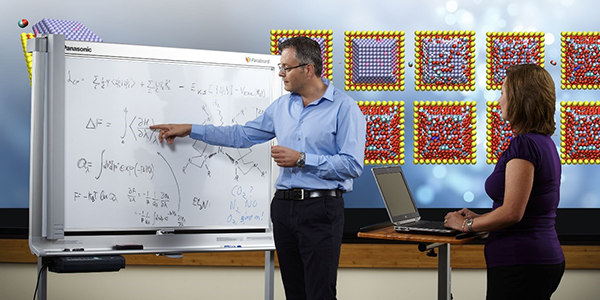Center for Molecular Electrocatalysis Takes on New Research Challenges
The U.S. Department of Energy (DOE) recently renewed funding for the Center for Molecular Electrocatalysis (CME) led by Pacific Northwest National Laboratory (PNNL).
Together with partners at Yale University, University of Wisconsin-Madison, Massachusetts Institute of Technology, University of Washington, and Purdue University, CME researchers are exploring fundamental scientific principles of catalyst design that underpin technologies such as solar energy and fuel cells.
In June 2018, DOE announced awards of $100 million for 42 new or continuing Energy Frontier Research Centers (EFRCs), including CME. These centers are charged with pursuing the scientific foundations of various aspects of energy production, storage, and use.
CME Director and PNNL Laboratory Fellow Morris Bullock, says the key factors in earning the renewal were the significant achievements in developing catalysts that can convert energy between electrical and chemical forms. There has been a significant evolution and new approaches to the work taking place at CME, which has formed a strong team that is focused on these new thrusts.
For example, based on the work of Shannon Stahl (Stahl Research Group) at the University of Wisconsin, CME researchers are pursuing the concept of molecular mediators. "Dr. Stahl has been developing the exciting notion of a hydrogen atom, or a proton-electron, delivered in organic solution, and then that molecule can go to the electrode for an electron to be added or removed," Bullock said. "We're calling it 'molecular mediators,' because it's a molecule that is mediating the catalysis. We believe this is a powerful concept, and the early results show that it can increase the rate and the efficiency of reactions."
Another new thrust—led by Yale University's Jim Mayer—focuses on heterogeneous interfaces as the basis for fuel production systems in the future. "We are working to improve our molecular-level understanding of the electrode; to take a molecular approach to electrode reactivity," said Bullock.
CME Deputy Director and Yale computational chemist Sharon Hammes-Schiffe works on and provides leadership to all of the new efforts.
Catalyst Design Thrust Lead and Associate Division Director of PNNL's Catalysis Science Group Aaron Appel says CME will continue its focus on the research and design of molecular catalysts. "One of the key challenges for PNNL and our partner institutions is to investigate the fundamental aspects of how we design catalysts for electrochemical transformations—fuel production and utilization, as needed for fuel cells."
According to Bullock, the CME partnership is energized about what lies ahead. "Our challenge is to improve reaction rates at the same time that we improve the overpotential (a measurement of wasted energy)," said Bullock. Often, we can get faster rates, but that comes at the expense of a higher overpotential, or vice-versa. What we're trying to do is take a system-level approach to the design of electrocatalysts and improve both of them at once. To do that, we need this comprehensive approach that looks at the molecular catalysts, the use of mediators, and understanding what's happening at the heterogeneous interface. That's why all three of these thrusts need to work together—with a significant interface to computational and theoretical efforts."
DOE established CME in 2009. Since that time, researchers have examined catalysts that convert electrical energy into chemical bonds and back again. Among the reactions studied is the production of hydrogen, which can be used in fuel cells. Most recently, CME has reported:
- The fastest electrocatalysts for production of hydrogen;
- The fastest electrocatalysts for reduction of oxygen; and
- The most energy-efficient molecular electrocatalyst for the reduction of oxygen.
These fundamental scientific achievements, says Bullock, are important for our energy future. "For example, a catalyst breaks chemical bonds to produce electricity in a fuel cell. An energy-efficient catalyst produces more power from fuel than an inefficient one—and fuel cells for vehicles need to release energy as fast as the explosions in a gasoline engine do," he said. "Our researchers' efforts have sharpened our collective understanding of the central challenges in the field and laid the foundation for the ambitious goals for future studies."

PNNL scientist Simone Raugei discusses computational studies that closely interface with experimental studies in the Center for Molecular Electrocatalysis.

